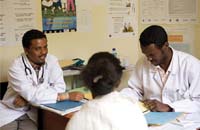18.2 The advocacy approach
The advocacy approach uses many different methods of reaching people. Inter-personal meetings or face-to-face approaches with the decision makers are the most effective advocacy approaches for those people. However, with the limited availability of advocates in the field, the potential number of people reached is limited using this form of communication, and further work like that may be expensive. As mentioned in earlier Sessions, you can also use other channels for reaching the public, for example newsletters, flyers, booklets, fact sheets, posters (Figure 18.2), video, dramas and folk media.

As an advocacy coordinator, you will need support and technical assistance, and possibly extra personnel to carry out your advocacy activities. You may need help in the areas of identifying health issues, planning, and message or material production. Some organisations that can help you carry out an advocacy campaign will have expertise in conducting advocacy campaigns, or be able to help you carry out needs assessment and issue identification. Other organisations may help with advocacy activities such as message development and broadcast work. Some will have expertise in audio-visual and media message production, while others may have expertise in training field workers for developing their advocacy and networking skills.
You may also need help when conducting meetings with higher officials. This experience and capacity may exist in either the governmental or non-governmental agencies found in your locality. Remember that the selection of supporting organisations able to assist you when you carry out your advocacy activities will depend on the political commitment that exists for the Health Extension Programme. This level of support is necessary to ensure that other governmental and non-governmental sectors collaborate and assist with the advocacy coordination. This in turn is affected by the particular health issue to be addressed, and the available funds to implement advocacy activities.
Make a list from your initial thinking of organisations that may be able to help you with your advocacy work in the future.
Of course we do not know your particular circumstances. However, if you had difficulty with this, then we suggest that you arrange to talk to experienced health workers in your area, as they will know who to turn to for help of this sort. Building good working relationships is the most effective way to support your advocacy activities and efforts. You can get support for your advocacy activities by identifying the governmental and non-governmental agencies responsible for your locality, and building a good relationship with their officials. Do not forget to meet with these groups and their representatives regularly.
Some possible advocacy resources for your locality include the woreda Health Office, the nearby health centre, local NGOs and other governmental sectors such as the Departments of Agriculture and Education, as well as local women’s associations and kebele leaders.
You need support to form an advocacy network because of the amount of work and the number of activities that may be involved. You may need help in order to design effective messages, to form a task force, to decide the strategy, and for fundraising, as well as for calculating the cost of the activities.
You also need to identify potential supporters. This can be achieved by attending local events, enlisting the support of the media, holding public meetings, and talking to all the influential people in your community. To do these things effectively, you will also need to do a community diagnosis and get to understand the resources in your community or locality. To get good support for advocacy campaigns (Figure 18.3), you need to form a cooperative team for your advocacy activities, and you need to know the stages to go through in order to achieve the best results.

18.1 Advocacy tools
